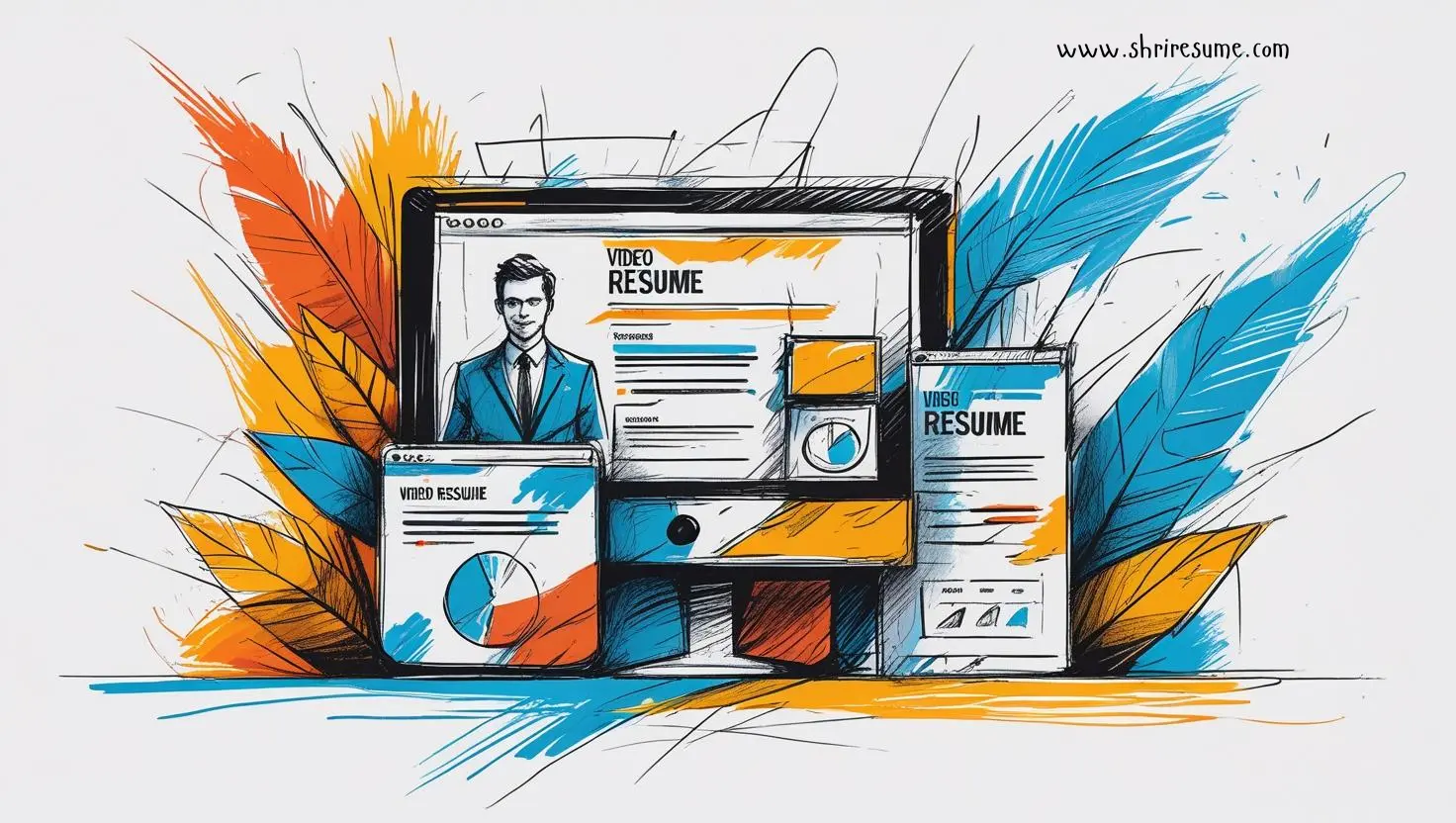Video Resumes vs. Traditional CVs: When to Use Which
Introduction
Time is changing, and many things in the job application process have also changed. Technology has brought new ways to profile professional skills and experiences. Among major innovations developed, two are distinguished. A video resume is one of the great innovations by which a candidate for work can briefly present himself to a future employer. While traditionally the norm for decades has been the CV, which offers a small summary of candidate professional history in a readable format, video resumes have popped up to provide a dynamic alternative that enables applicants to display their personalities and soft skills more adequately. The part of the article is devoted to the differences between video resumes and traditional CVs, when and why one or another should be preferable in the competitive job world.
Understanding Traditional CVs
The Curriculum Vitae, commonly called the CV, is the main document for job application requirements over the years. This is backed up by the days when it was paramount to document the professional journey so that one can get ahead in the career. Traditional résumés included sections such as personal details, education, work experience, and the section of skills and references sometimes even in a very orderly format.
Key Components and Format:
- Personal Information: Name, contact details, and sometimes a professional photo.
- Education: Academic background listed in reverse chronological order.
- Work Experience: Inclusive of previous work experiences, including job titles, companies worked for, and date from-to periods of employment, emphasizing briefly in bullet points the duties and achievements.
- Skills: A summary of relevant skills, both hard and soft, pertinent to the job application.
- References: Upon request, details of professionals who can vouch for the candidate’s abilities and work ethic.
Advantages:
- Universality: Almost all employers accept and expect traditional CVs, making them a safe choice.
- Clarity: Provides a clear, chronological view of one’s professional path, making it easy for employers to scan quickly.
- Simplicity: Easy to update and tailor for specific job applications without needing specialized skills.
Disadvantages:
- Limitations in Representation: Traditional CVs have various limitations in the representation of a personality, creativity, or soft skill of an applicant.
- Competition: With many CVs adhering to similar formats, standing out among a sea of applicants can be challenging.
Traditional CVs with their simple and standardized format were classic and timeless, as they greatly suited the systematic review of many employers. Traditional CVs are far too short of portraying any sort of individual personal flair, which results in the prevalence of video resumes for industries that require creativity and innovation to be the order of the day.
Exploring Video Resumes
A video resume is a brief video developed by a job applicant to outline his or her experience and skills more dynamically than a standard resume. That is the reason this format provides candidates with room to display qualifications and talk more about their personality, communication skills, and even creativity. Job seekers are now using the format in the interviewing part of their search for marketing, design, and communications positions. This is now being taken to a higher level, especially with the coming and going of digital media, placing more value on personal branding.
Key Elements to Include in a Video Resume:

- Brief Introduction: A short introduction of the candidate, including their name and the role they’re applying for.
- Professional Summary: Highlighting experiences, achievements, and skills relevant to the job.
- Personal Touch: Sharing personal projects or passions related to the field can make the video more engaging.
- Call to Action: Ending the video with a clear invitation to contact or learn more about the candidate.
Advantages:
- Personality Showcase: Offers a unique opportunity to display personality traits and soft skills.
- Engagement: A well-crafted video can capture the attention of employers more effectively than text.
- Differentiation: Helps candidates stand out in a competitive job market by showcasing creativity and initiative.
Disadvantages:
- Time-consuming: Creating a video resume that will look professional is time-consuming with the efforts of pulling out your video editing tool .
- Industry Acceptance: Not all industries are receptive to video resumes, with some preferring the traditional CV format.
- Technical Challenges: Lack of technical skills or resources to produce a high-quality video can hinder effectiveness.
The advent of video resumes reflects an even more general trend toward personal, interactive forms of communication. When well-used, they can be very effective at making an impression that sticks. Appropriateness, however, often depends on the industry and the nature of the job being applied for.
When to Use a Traditional CV
The digital age has brought with it a fresh way of doing job applications, but the traditional CV still finds itself well entrenched in many professional environments. Knowing where this tried-and-true format might be in use could greatly impact your job application.
Industries and Scenarios Favoring Traditional CVs:
- Conservatism: Conservative industries, such as finance, law, or healthcare, basically prefer the formality level and directness of traditional CVs.
- Roles Highlighting Qualifications: Through the roles that focus on drawing attention to certain degree specializations, certifications, or technical skills, a CV serves to these positions in a clear and brief manner.
- High Volume Applications: This is for job postings most likely to generate a huge volume of applications on the part of the employer. Traditional CVs are usually quicker and much easier to review during processing.
Tips on Crafting an Effective CV:
- Tailor Content: Customize the CV for each job application, highlighting the most relevant experience and skills.
- Keyword: Sprinkle some of the industry words that are relevant to the job within your resume to beat the automated applicant tracking systems (ATS).
- Clarity and Conciseness: Keep the layout clean, and the content focused, ensuring easy readability and quick scanning.
Going for a traditional CV doesn’t mean you miss out on the scope to show off your personal traits and soft skills. Both could be dynamically shown during the cover letter presentation or the interview. You just need to understand what the industry and particular employer expect
When to Use a Video Resume
Video resumes aren’t appropriate for every job application; however, they can add a tremendous amount of value to your candidacy by providing an energetic, engaging representation of you as a professional.
Situations and Fields Where Video Resumes Shine:
- Creative industries: If you’re keen on entering an industry such as marketing, advertising, design, or media, the video resume may well double up as a piece within your portfolio easily created by your creativity and technical know-how.
- Roles Requiring Strong Communication Skills: Positions that value presentation, public speaking, or language skills benefit from the direct demonstration a video resume offers.
- Personal Branding: In some applications for which the personal brand and the personality are key, a video resume is a very useful means to bring across one’s unique selling proposition.
Crafting an engaging video resume really does take some level of planning, creativity, and a smattering of technical know-how. Tools like video editor makes that job much easier by letting you add text overlays, piece together multiple takes, and add some relevant work samples. There is not only the proof of your professional qualifications but also the evidence of your ability to use modern digital tools effectively in your work.
How to Create a Video Resume:
- Keep It Short: Aim for a video length of 1-2 minutes to hold the employer’s attention.
- Be Professional: Dress accordingly and use a clean, uncluttered background even if you are in the creative industry.
- Highlight What Makes You Unique: Use the video to complement, not repeat, your traditional CV, focusing on experiences or skills that are better demonstrated visually or orally.
Comparative Analysis: Making the Right Choice
The preference for a video resume over a traditional CV, for the greater part, is a function of your perception of the job, the industry, and your strengths. If the position calls for words such as “personality” and “innovation,” a video resume will be apt to capture your creative bent and dynamism. On the other hand, an ordinary résumé would lend itself well to providing a clear and full description of your professional history, in roles that required clear detail of qualifications and experience.
Decision-Making Criteria:
- Job Type and Industry: Creative fields and profiles where personality and communication skills are involved are very receptive to video resumes.
- Personal Strengths: If your strengths lie within your academic background and work experience, then perhaps a traditional CV may be more befitting for your needs.
- Employer expectations: Kindly paraphrase to the best format that captures the company culture and job description below, as per the format that best captures the values and expectations of the employer.
Conclusion
Having both a traditional CV and a video resume in your tool belt means that you will have an answer for any kind of application situation that comes your way in the moving job market. While traditional resumes provide a standard format of qualifications and experience, a video resume would let you sell your personality, creativity, and communication skills. The idea is to choose a format that best showcases your strengths and very readily follows the expectations of your target industry and position. Always remember, the idea is to create an impact that may last in the mind of the potential employer, to present more effectively in the format of showcasing the unique value proposition.

Get a higher quality resume format
Our Resume Builder ensures best practices, logic, formatting standards and job matching opportunities from thousands of job boards and portals around the world.
By clicking Start Your Resume, Your are agree to our Terms of use and Privacy Policy
 India's
premier resume service
India's
premier resume service






